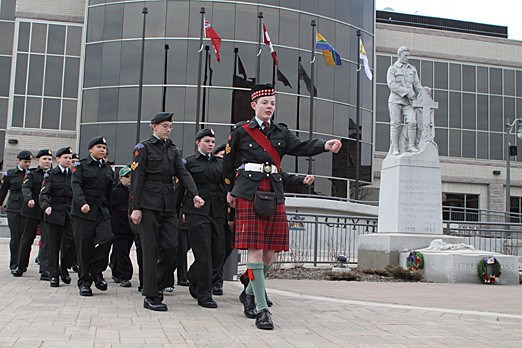Army cadets wanted to honour their own campaign and chose the Battle of Vimy as it forged Canada as a nation, says the director of the Army Cadet League of Canada of Northwestern Ontario.
Both of Thunder Bay’s army cadet corps attended the ceremony outside city hall Saturday. It marked the 94th anniversary of the battle that took place during the First World War. Vimy was the first time all four divisions of the Canadian Expeditionary Force joined in battle, elevating the fight to a national symbol of achievement and sacrifice.
It’s considered by many to mark the birth of the nation, independent of its British roots. Canada lost more than 3,500 soldiers in the battle.
"The army cadets never had anything as a group to contribute to Canada," Gerry Kosoris, director of the Army Cadet League of Canada Ontario, said. "In conjunction with the Vimy Foundation and the Royal Canadian Legion, we chose to commemorate Vimy. It was a battle that forged Canada as a nation. Vimy was a turning point for us. Until then we were known as a colonial country."
Kosoris said it’s important to know Canadian history to know exactly why soldiers fought and died for their country. Kosoris pitched the idea to have the ceremony as an annual event to the City of Thunder Bay about two months ago.
City administration went above and beyond to have the event ready for April 9 and Kosoris couldn’t be happier with the results, he said.
Kosoris and acting mayor Iain Angus handed out Vimy pins to each cadet. The pins were issues in 2009 as a way to further remember the battle.
The four coloured boxes represent the four Canadian divisions, the red represents the First Division, the dark blue the Second Division, the grey-blue the Third Division, and the green the Fourth Division.
Cadet Joey Bush, 15, with the Lake Superior Scottish Regiment, placed his pin on his uniform after the ceremony was over. Following in his great uncle’s footsteps, he said he joined the Scottish regiment because it was something he always knew he wanted to do.
As he looked at the pin, he said it’s important to remember Canadian history.
"I think it is important to know important places in our country’s history," Joey said. "There’s a lot of people who might forget about the past but we can’t. It’s Canada’s first major involvement as a country in a war."
Sign in or register
- Messages
- Post a Listing
- Your Listings
- Your Profile
- Your Subscriptions
- Your Likes
- Your Business
- Support Local News
- Payment History
Registered Users
Already have an account?
New Users
Create a free account.
